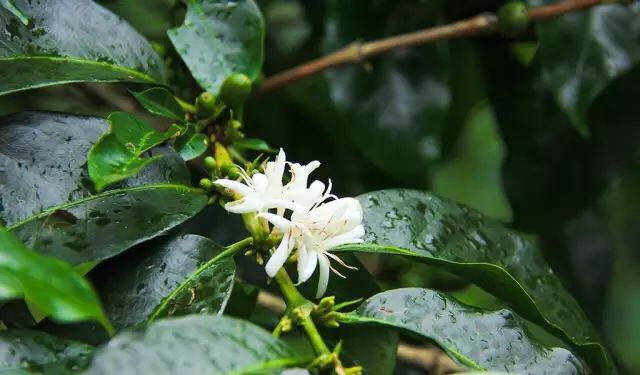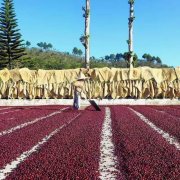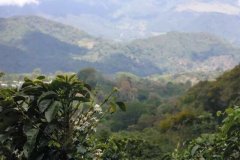Introduction to microclimate and environmental quality of Antigua, a famous producing area of Guatemala
Antigua coffee
Antigua Valley, Guatemala has long been Guatemala's most famous coffee-producing area, Antigua Valley micro-climate provides excellent conditions for growing coffee, such uniqueness is known worldwide. The region's path to fame began decades ago when some Japanese coffee traders discovered superior coffee here. The combination of rich volcanic soil, low humidity, plenty of sunlight and sharp differences between day and night creates the personality of Antigua coffee. The valley consists of three volcanoes: Agua, Acatenango and Fuego. Every once in a while Fuego adds fresh and rich ash to the environment. The ash is rich in minerals and also provides soil growth conditions that help retain moisture against Antigua's dry climate. Like all coffee grown in Guatemala, Antigua coffee grows in shade, which not only protects the coffee from the cold December to January nights, but also creates an ecological corridor for wildlife in this subtropical region.
microclimate information
Climate: The climate in this region is mild, with an average annual temperature of 22°C. The Antigua Valley is surrounded by mountains and volcanoes that protect it from the north wind.
Altitude: Located at an altitude of 1500 meters, it produces very hard bean (SHB) quality coffee.
Weather: The rainy season lasts six months from May to October and the dry season from November to April. In the dry season, temperatures are cool around 14°C from November to January, and warm with an average temperature of 24°C from February to April. Such a unique climate creates a special coffee producing area. The average annual rainfall is about 1200 - 1500 mm.
Soil: Volcanic soil mixed with fresh volcanic ash, rich in minerals and nutrients, is ideal for coffee growth. This area and valley used to be a lake, so the sediment left behind makes the land fertile and has strong characteristics, affecting the unique quality of coffee.
Cultivation: Most coffee is Arabica bourbon and grown in the shade of Gravilea trees. Coffee is carefully picked and selected at maturity and transported to La Esperanza, a washing plant on the outskirts of Antigua.
Coffee processing: coffee is carefully processed in a washing plant and separated by a peeling machine. The final pulp is then removed by fermentation and washed with clean water. Coffee is 75% sun dried. Carefully dry according to customer requirements and ensure consistent quality of each bag, every batch of harvest.
Flowering season: flowering begins in late april or early may and harvesting begins from december to march. Such high-quality green coffee beans are usually available in mid-January.

Important Notice :
前街咖啡 FrontStreet Coffee has moved to new addredd:
FrontStreet Coffee Address: 315,Donghua East Road,GuangZhou
Tel:020 38364473
- Prev

How Guatemala gave birth to the unique "cigarette coffee" Antigua
There are many counterfeit Antigua coffee products. When it comes to the real Antigua coffee association, it is necessary to mention the Antigua Coffee Association. In 2000, counterfeit Antigua beans were rampant. The authentic Antigua Coffee Farmers Association (APCA), composed of Antigua coffee farmers and producers, was listed for operation with the support of the government. 34 Antigua manors joined. Antigua beans purchased by Osher all belong to this association.
- Next

Raminita Group's Flower God Coffee Antigua's top boutique coffee flavor introduction
Today, most of the coffee industry's production takes place in the south of the country. Guatemala has seven main coffee producing areas: Antigua (Antigua), Cobain (Coban), Lake Attilan (Atitlan), Vevetnango (Huehuetenango), Farahan Plateau (Fraijanes), Oriente (Oliente) and San Marco (San Mareos). Each region has its own climate change.
Related
- Detailed explanation of Jadeite planting Land in Panamanian Jadeite Manor introduction to the grading system of Jadeite competitive bidding, Red bid, Green bid and Rose Summer
- Story of Coffee planting in Brenka region of Costa Rica Stonehenge Manor anaerobic heavy honey treatment of flavor mouth
- What's on the barrel of Blue Mountain Coffee beans?
- Can American coffee also pull flowers? How to use hot American style to pull out a good-looking pattern?
- Can you make a cold extract with coffee beans? What is the right proportion for cold-extracted coffee formula?
- Indonesian PWN Gold Mandrine Coffee Origin Features Flavor How to Chong? Mandolin coffee is American.
- A brief introduction to the flavor characteristics of Brazilian yellow bourbon coffee beans
- What is the effect of different water quality on the flavor of cold-extracted coffee? What kind of water is best for brewing coffee?
- Why do you think of Rose Summer whenever you mention Panamanian coffee?
- Introduction to the characteristics of authentic blue mountain coffee bean producing areas? What is the CIB Coffee Authority in Jamaica?

